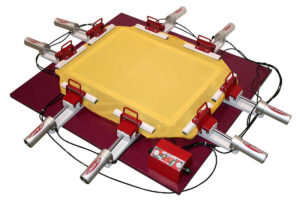

Революция в индустрии трафаретной печати благодаря передовым технологиям и качественному обслуживанию
Anatol Equipment Manufacturing Co.
1429 S Shields Dr
Waukegan, IL 60085


Революция в индустрии трафаретной печати благодаря передовым технологиям и качественному обслуживанию
Anatol Equipment Manufacturing Co.
1429 S Shields Dr
Waukegan, IL 60085

There are several different types of screen printing frames to choose from — find out which work best for you!
In the end, the best screens for your shop may, in fact, be a mixture of screens with different frame types. By understanding the benefit of each type of screen, you can best tailor your print shop’s screen supply to match your printing needs.
Hands down, the biggest advantage to wooden frames is the price. Wooden frames are noticeably cheaper than their aluminum, steel and retensionable counterparts. The low price point is a major draw both for screen printing shops that are just starting out and looking to build their screen stock quickly and relatively cheaply and established shops looking to cut costs.
The drawback to wood frames, however, is their lack of strength and durability. Wood frames can come out of the box already warped, due to the strength of the wood not standing up to the tension of the screens. Wood screens also deteriorate significantly over time. The rinsing out and washing of the screens and the exposure to screen printing chemicals will degrade the wood, causing it to warp further and loosening the tension of the screen. Wood screens also can be heavy to haul around a shop.
Despite the disadvantages, there can be a place for wooden screen frames in your shop. If you plan to use the same screen over and over again — as opposed to washing away your stencil and repurposing the screen — wooden frames can hold up for some time. They also can be used on projects with large, simple prints, or prints that don’t require extremely accurate registration, without compromising the quality of your products. By using wooden frames on the right types of jobs, they can present your shop with a way to save money on supplies.
For all-purpose jobs, metal screens are a reliable standby. They’re more expensive than wooden screens, but not by a significant measure. Because of their strength and durability, metal-framed screens will hold their tension longer than screens on wooden frames. If you opt for aluminum screens, as opposed to steel, they’re also much lighter and easier on your printers and your presses than most wooden screens.

Like wood-framed screens, metal-framed screens will lose their tension over time. The advantage with metal frames is that they can be stripped and rescreened, and many screen printing supply companies offer this service. So while metal screens might be a more significant initial investment, the longer life of the screens helps to negate the up-front cost difference between a wooden and a metal frame.
For projects that require higher tensions and fine detail, retensionable screens are often the right choice. With retensionable screens, you can increase the tension of your screens to your print specifications with the turn of a wrench. You also can tighten a screen that you notice has loosened or is beginning to sag. Higher screen tensions allow you to print crisper details faster, with less off-contact distance and using less ink. Another benefit of retensionable screen frames is that they can be fitted with specialty mesh. That can save you from having to purchase many different specialty screens that you might only use a few times a year.
The biggest drawback to retensionable screen frames is the price tag. They do cost significantly more than their wooden or static metal counterparts.

Anatol’s pneumatic screen stretcher helps you keep proper
tension for almost any combination of frames and mesh.
If you want to get the biggest bang for your buck when it comes to purchasing screens, the trick is to mix your screen stock so you have the right frames for the right projects. You know you can use wooden frames for simple jobs that you’ll complete over and over again. Static metal frames are a good go-to for day-to-day printing. Investing in a few retensionable screens can allow you to print detailed projects that require higher tensions, or they can allow you to use specialty mesh without investing in a whole new screen. Whichever screens you choose to buy, make sure you invest in quality screens from a reputable supplier; budget frames, no matter their material, will be doomed to fall apart quickly and require a fast replacement.
Looking for more tips to help you get the best screen printing results? Keep checking our blog, or get in touch and let’s talk screen printing!
Your message was successfully sent!